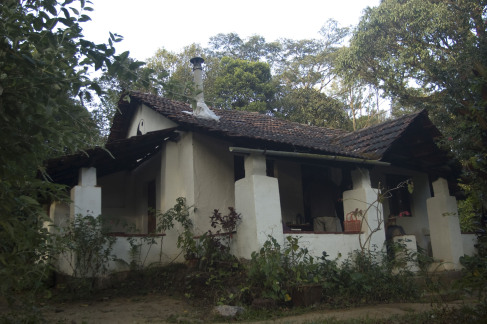
If man learnt the blues pickin’ cotton, he shall rediscover it learning how to grow coffee. And no any ordinary coffee, mind you, but organic gourmet robusta.
The upper echelons of Coorg’s rain-slopes resonate not with the hum of mountain maidens, but Big Mama Thornton belting away the blues. Welcome to Mojo Rainforest Retreat, a 25-acre organic farm perched at 1100m in the lush Western Ghats of Karnataka. Mojo is as famous for its unimaginable shades of green as for its collection of blues, believed to be the largest in the country. If Robert Johnson’s wandering soul were to reincarnate as a farmhand, this is where it would come to rest.
Take it from Doc. That’s Doctor Anurag Goel, who claims to have seen every big blues act while doing his Ph.D. in Molecular Biology from Toronto. His wife Sujata, a Ph.D. from the Department of Botany (Delhi University), is a walking encyclopedia of natural remedies. Along with their ‘nature child’ Maya, the Goels have accomplished what most people only dream of in their dreams. They quit the rat race of urban drudgery to pursue a more harmonious existence with nature.
After extensive travel through this vast country, they chose to settle in the rainforests of Coorg. The retreat was set up in 1999 to raise awareness about their environmental NGO.
Initially, they intended to name it Worldwide Association for Restoration and Preservation of Ecological Diversity but realized that a name like WARPED would find little credibility.
And so, after a little juggling of alphabets and a National Geographic grant later, they settled for WAPRED Research Foundation in 1996. Today, the idea has blossomed into a heady mix of eco-tourism, offbeat adventure travel and the blues.
Coorg’s rich flora and fauna have earned it international recognition as one of the most important hotspots of biodiversity that need to be preserved. To say that it’s a challenge is an understatement. This here is Wild West Country, where every house boasts of a licensed rifle and most of the region’s wildlife can be found on the walls of living rooms in Coorg.
Some of course, like the wild boar, have met a more honourable end. The transformation from a vile burrowing creature to a bowl of delectable pandi-curry can only be attributed to the genius of a people who have understood the very soul of the animal.
Sadly, the importance of nature’s treasures has been lost on them. The heavy use of toxic pesticides has seriously endangered the region’s fragile eco-system.
The falling prices of coffee have spurred the use of chemical fertilizers and a mysterious disease has wiped out the orange from ‘Orange County’. However, there’s one bastion that seems to be holding out – Mojo.
The farm is a perfect example of how to live in harmony with nature without necessarily exploiting it. The Goels use solar panels for their basic power supply. Crops are grown under the shade of rainforest trees using biological methods of pest control.
A medicinal plant garden nurtures the wealth of traditional knowledge.
Coffee berries are handpicked, hand-processed and specially roasted to obtain a special blend without using chemicals or chicory.
The cuisine – mostly locally grown organic produce – is a delicious blend of continental and Indian dishes, homemade bread, cottage cheese, pastas, roasts, preserves and gourmet organic coffee.
Even the accommodation at the Rainforest Retreat is an unforgettable experience. A beautiful brook-side bungalow, set in a picture-postcard thicket of bamboo, banana, orange and pineapple, conforms to international standards of style and comfort. It has two bedrooms, a spacious living room, sit-out and perhaps the best rainforest loo any side of the equator.
A second, more rustic shelter is the Yin Yang Cottage inside the plantation. A thin wisp of smoke rising from the bathroom chimney indicates that Muttu Pandey (the farmhand) has already heated the water. Before the stimulating bath can lull me to sleep, there’s a Doc on my door. It’s time for a first-hand learning experience at the farm.
Mojo is home to the Habanero, the world’s second hottest chili. The Red Savina Habanero used to be the hottest until it was deposed by our own Nagahari chili from Tezpur, Assam.
Another brilliant flash – this time at the treetop – catches my eye and I wonder if it’s a bird, a plane or Superman. Doc angrily shakes his head and says it’s the Southern Birdwing, India’s largest butterfly.
There’s Dendrobium Nutantiflorum, he motions to an orchid clump and that’s the raucous call of a Green Barbet. Stupefied, I try to keep pace with one new discovery a minute and forget more than I can remember.
Doc plays the razor-sharp schoolmaster to my stupid boy from Botany class. A walk through the dense cardamom under-hang leads to a clearing where Doc comes to a halt in front of a tree.
He has the reverence one would show to an Inca shrine. With all the compassion of a shaman consecrating a totem, he caresses the thick leaves of a creeper. “After saffron, vanilla happens to be the most expensive spice in the world”, he chuckles. “One kilo of cured, processed vanilla extract fetches as much as Rs.11,000 in the international market.”
But before this article can trigger off rampant cultivation of vanilla in any available garden patch, let me add that it takes 5 kg of beans to process 1 kg vanillin extract. A lucky farmer may get about Rs.700 for a kilo of beans.
What’s more, in the absence of its natural pollinator the Melipone bee, the orchid’s flowers have to be hand-pollinated. The flower opens in the morning and closes in the afternoon, never to open again. If left pollinated, the flower will drop the very next day.
Oddly content that I was not a vanilla farmer, I pick up samples of the local produce. Habanero extract, cardamom, pepper (which are indigenous), coffee (which was introduced), Garcinia (aka Kokum, used as a refreshing drink and a souring agent in curries) and a lovely set of picture postcards, all of which fund WAPRED.
Back at the main house, Sujata thrusts into my hand what she calls a ‘hibiscus suspension’. I admire the glass like a potential Nobel Prize winning entry, when a patient feminine voice explains, “It’s a coolant; you are supposed to drink it”.
“And next time, use kerosene on your boots. It’ll keep the leeches away”.
This region gets so much rainfall it would make Mawsynram blush. The rains get so severe that leeches give up their positions on the ground and cling to overhanging branches to throw themselves like kamikaze warriors on to passing targets. If you’re into pain, I highly recommend Mojo in the monsoons.
Among the other denizens of the farm are the dogs – Jupiter, Janis (named after Janis Joplin), UB (Ugly Bastard – a deformed puppy who has grown up into a stocky watchdog) and Pigpen (from a character in Animal Farm), who died recently. It’s advisable to be overtly good to them as it is they who accompany you from the main house to the Yin-Yang Cottage at night.
A solitary jaunt is not exactly spooky, but jungle walks have never been the same after The Blair Witch Project. Everything at Mojo – including Aki the Calf and Maya Hill – has been named by 4-year-old Maya. If she has finished partying with McDuff, John Barleycorn (who has a drinking problem) and her imaginary friends, maybe she’ll show you her ‘panoramic view’ and tell you about her philosophy.
Meanwhile, a Golden Oriole lands on the tree near the verandah. While I gape open-mouthed at it like a 4-year-old kid, an oblivious Maya is content watching UB play with a ball-beetle.
Mojo is the sort of place where you’d hate to blink. It tends to leave you with a strange feeling that can best be described as a mixture of envy, awe, respect, rejuvenation and rage when the honeymoon is over. However, for those few precious moments, it gives people a chance to experience an inner peace that only nature can provide.
Doc has also designed several escorted road tours that take you to interesting places nearby. There are excursions to other plantations like Ludwig Mahal, a nature walk to Galibeedu Ridge, a visit to the Dubare Elephant Training Camp and an insane drive to the Cauvery for swimming and mahseer fishing.
What makes Mojo even more special is that it’s a Mecca for bird-watchers, insect-lovers, soul-trippers and blues-brothers. The misty mountains and dense foliage of this section of the Western Ghats make it one of the best places to get lost.
In fact, Mojo adds up to such a wild weekend you might even be tempted to call it a ‘Doc Holiday’…
Author: Anurag Mallick. This article appeared in the May 2003 issue of Outlook Traveller magazine.
source: http://www.redscarabtravelandmedia.wordpress.com / Blog by anurag mallick & priya ganapathy / May 25th, 2012




